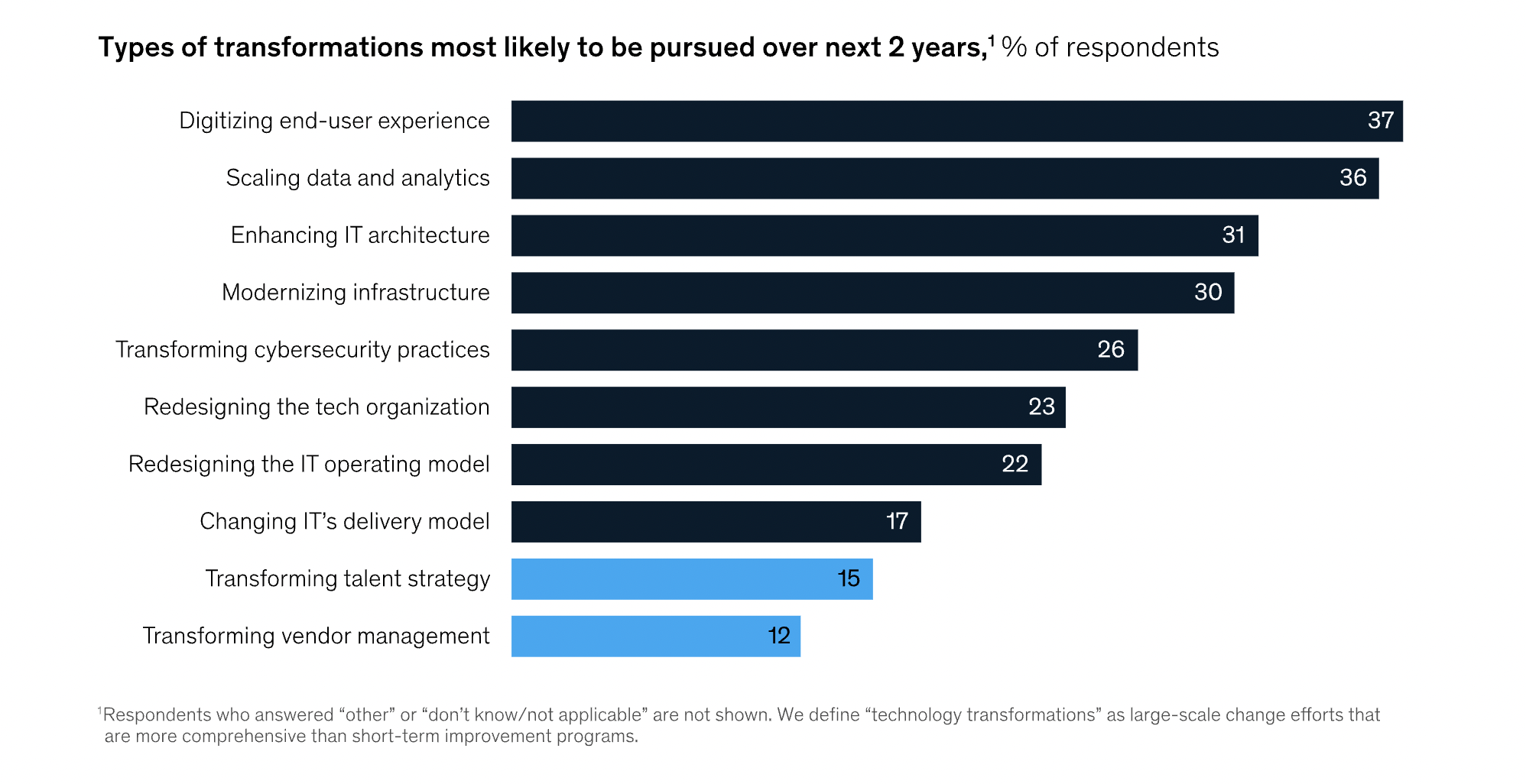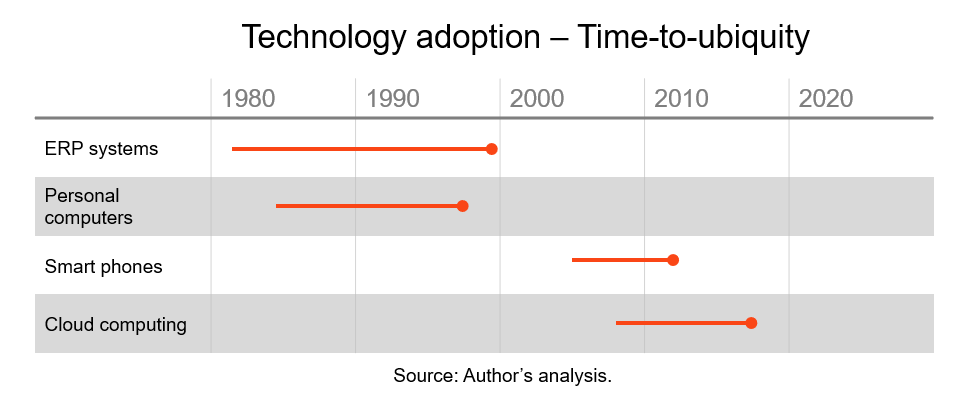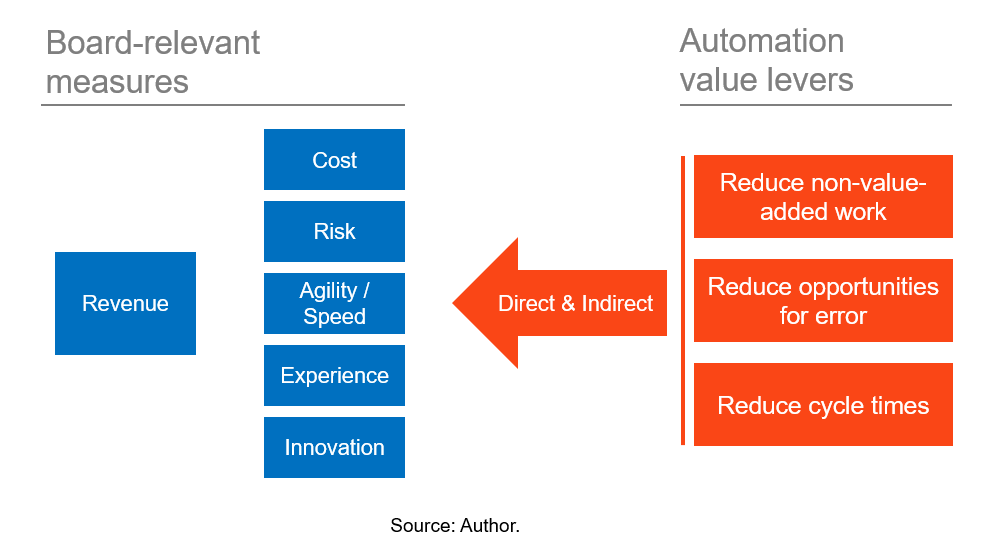Automation's Value in the New Economy
Share at:

The economy just got faster.
In the pre-COVID competitive environment, leading firms focused on the digital transformation of their business and the pursuit and retention of increasingly scarce top talent. As we transition to a new economy, the same business imperatives remain central to business leaders. But pandemic-induced structural market changes have increased the velocity of market disruptions and the need for business adaption and innovation to survive.
A recent New York Times headline captured the reality: “CEOs are forced to embrace uncertainty.”
Automation is an essential enabler of firms’ digital transformations and managing uncertainty. Automation includes robotic process automation (RPA), artificial intelligence (AI), process and task discovery, and automation demand management on a robust enterprise platform. While recognized as an effective cost take-out strategy, automation offers firms a wider set of Board-relevant value, including quality, risk, agility, and experience.
Firms that effectively unlock automation’s full potential find they reap follow-on value when the ease of automation imbues the entire workforce with an empowered, innovation mindset.
In the accelerated new economy, automation will be key to firms maintaining their competitive position, adapting to market changes, and dominating their markets.
Business context
Before times
Back in January 2020, enterprise leaders’ dual focus was business digitalization and the competition for talent.
Becoming digital had become competitive “table stakes,” just as enterprise resource planning (ERP) systems were in the 1980s.
Strategists and business press focused on the aging workforce, the remaining labor force’s skill gaps, and the generational divide regarding workplace technology expectations.
COVID
Then COVID-19 happened. In a matter of months, the world economy changed. COVID variants’ persistence means we are not going back.
New economy
The current economy looks notably like the pre-COVID economy, only faster. We are in the new economy.
Competition for talent redux: the “Great Resignation”
While the pre-COVID labor market was tight, it's even tighter in 2022. Knowledge worker talent—the engine of digital firms—is increasingly scarce, expensive, aging, and restless. Recent headlines are sobering for knowledge firms.
There were 10 job openings for every seven job seekers at the end of 2021
Emirates Airline has seen the applicants per call center job opening drop from 80:1 to 10-15:1
Call center starting wages increased by 33% in 2020 and knowledge workers’ by 3.9% in Q4 2021
More than a third of female middle managers expressed the intent to leave their current jobs in 2022
By 2030, millennials will make up 75% of the workforce
Recruiter.com’s CEO, Evan Sohn, told The Wall Street Journal, “The job hopper economy is not going backward.”
The Great Resignation means that firms’ knowledge, skills, and experience are walking out the door.
Firms’ inability to retain talent threatens their performance, competitiveness, and speed of their digital transformation.
Digital acceleration
Leading firms have doubled down on digital investment. A 2021 McKinsey Global survey found 37% of firms expect to invest more in digitizing end user experience over the coming two years:

And business is not waiting on IT. The same study found that top-quartile performing firms were four times more likely to have joint business- and technology-integrated value creation models.
Automation, as a core element of digital strategy, is accelerating. Research suggests that up to 50% of administrative work will be automated by 2030. A 2019 global shared services survey indicated a shift to knowledge work, as purely transactional work was increasingly automated away.
Yes, those are the sounds of competitors’ footsteps you hear just behind you.
Accelerating the rate of disruption
COVID increased that rate of change and disruption. The elapsed time from disruptive technology introduction to ubiquity dropped 50% in 40 years (see Figure 1).

COVID changed the location of work for many in just weeks. Headlines suggest this may be permanent. The assumption of markets’ multi-year stability and predictability no longer holds. Key global market indicators all point to rising volatility:
The International Monetary Fund World Uncertainty Index grew steeply since 1990
Economy-disrupting natural disasters in the United States (U.S.) increased 315% since 1990
Global supply chains are unpredictable and costly, with increases of up to 500% in 2021
And, as of this writing, the yet unknown consequences of Russia’s war on Ukraine.
Agility is both a competitive advantage and a minimum condition for survival in the new economy.
Automation’s value
Automation provides three value levers:
Productivity: reduction in non-value-added labor
Quality: reduction in error rates
Speed: improvements in cycle times
These value levers have broad application to deliver Board-relevant value across five dimensions: cost, risk, agility/speed, experience, and innovation (see Figure 2).

Let’s review automation’s potential across each of these value dimensions.
Cost
Reducing non-value-added human labor is the paradigmatic value of automation. Through automation, the same amount (and cost) of human labor can be more productive, thereby improving cost of goods sold (COGS) or sales, general, and administrative (SG&A) costs.
Where and how these automation-derived productivity savings are 'banked' is dependent upon the firm’s—and often the specific operating unit’s—immediate challenges. Productivity savings can be banked as:
Headcount reduction labor savings
More process throughput and revenue with unchanged labor cost structure
Productivity savings can be banked by releasing fractional portions of existing labor’s time to perform other work that is not directly measurable in process throughput.
This released capacity can substitute for costs of seasonal flex capacity or consulting services, providing savings to the firm, albeit often on a different budget line.
Risk
Risk is cost that has not hit the balance sheet. Yet.
Automation’s improved quality value lever addresses contractual, regulatory, and reputational risk. Automation tools remove repetitive, predictable, error-prone steps from human action. The fewer opportunities for error in an end-to-end process, the fewer errors are likely to occur. As decades of process improvement studies have demonstrated, you can pay a little for quality up front or you can pay a lot to fix poor quality later—often five times more.
COVID demonstrated that bad things happen to good firms that are not resilient. Organizational resilience stems from overall simplicity and transparency of the business model and processes. COVID and supply chain disruptions evidence the need for end-to-end process transparency. Firms can no longer afford “black box” steps in their value chain.
Automation tools, including task mining and process mining, help firms mitigate value chain risks, including business process outsourcing (BPO) and key person risks. Task and process mining tools capture end-to-end and cross-system processes and the implicit knowledge that only those few seasoned workers have.
Further, unlike many BPO contracts, automation robots can handle dramatic changes in transactional volumes without performance failures and without cost penalties.
Agility
Agility is a firms’ ability to change quickly and deftly as market changes pose threats and time-sensitive opportunities. Automation provides a faster time to value, when business processes must change.
Every firm relies on a complex array of enterprise transactional systems: customer relationship management, sales, supply chain, procurement, manufacturing, logistics, service, finance, and human capital management. End-to-end seamless process integration across transactional systems is inherently complex. Ideally, cloud computing and API architecture provide seamless enterprise architecture integration. Yet, often business needs outpace the technology team’s ability to deliver. The new economy, with its increasing rate of change, exacerbates the IT backlog issue, forcing IT to say “no” to more legitimate, but lower priority, requests.
An automation platform provides a low complexity overlay to enterprise transactional systems that allows IT to address more business change demand faster, without adding to enterprise technology stack complexity.
A low-code integration across siloed systems can be developed, tested, and deployed in weeks. The same change done across two or more enterprise application teams might take months or quarters.
Time is money in the new economy.
Experience
Automation’s quality and speed levers directly contribute to customer and employee experience value.
Customer experience
Customers who experience first-time right processes and faster start-to-finish times will be more satisfied and more loyal. Reductions in error rates correlate with improved customer satisfaction. Similarly, improved call and service request resolution times contribute to customer satisfaction (CSAT) metric improvements.
Improved CSAT yields increased revenue through upsells to existing customers and reputation-based sales expansion to new customers.
On the cost side, improved CSAT reduces customer attrition, thereby reducing customer acquisition costs.
Employee experience
Similarly, automation’s contribution to employee experience is both direct and indirect, but real. Automation that removes tedious, repetitive, rote manual work improves employee experience and increases employee engagement. This has measurable bottom-line impact to firms. Brookings Institute research found:
Employees who experience their work as meaningful are less likely to call in sick, more likely to participate in skills training, and want to postpone their retirement
A sense of autonomy and relatedness to the work are the most important drivers of employees experiencing their work as meaningful— 20 times more important than income
McKinsey& Company research found that when employees find their work meaningful:
They are 75% more committed to the organization
and 49% less likely to leave.
Instead of asking 'Can I eliminate this employee?' Ask: 'Can I tailor this job to eliminate routinized, dead-end encounters with customers and allow employees to respond fluidly to their needs while developing a bond with them?'
Ryan Buell, Professor, Harvard Business School
Reduction in undesired attrition is a direct cost savings. The full replacement costs of an employee range from about 35% of an annual salary for a call center agent to 150% for a senior manager or technologist. These hard dollar costs include recruiter time, hiring bonuses, training costs, initial lower productivity, and temporary labor or overtime vacancy coverage.
In addition to lower attrition rates, engaged employees contribute more value—they are 33% more productive on average. As one chief human resources officer aptly put it: “The point of employee engagement is to unlock discretionary effort—employees going above and beyond” (quoted in Jacob Morgan, 2017, The Employee Experience Advantage, emphasis added). This brings us to the last value dimension of automation: innovation.
Innovation
Automation allows firms to shift to a pervasive innovation culture. Innovation can happen at any level of the firm and in any functional area of the firm if management enables it. The Toyota Way transformed manufacturing work. It was premised on listening to and empowering line workers’ improvement ideas. The same holds true for knowledge work.
The Toyota Way is supported by two main pillars: 'Continuous Improvement' and 'Respect for People'. We are never satisfied with where we are and always work to improve our business by putting forward new ideas and working to the best of our abilities.
Toyota Way 2001, Toyota Motor Corporation
The sum of innovation: 1 + 1 = 2
Smaller value contributing ideas are still accretive to the firm, if captured. Low-code citizen developer solutions dramatically reduce the cost of solution delivery, lowering these small automation business cases’ ROI threshold. Further, the citizen developer model places the automation labor cost burden onto the business unit that will gain the value of the automation, while reducing IT backlog.
Related article: Understanding Citizen Developers: Your Secret Weapon in Scaling Automation
Often, line workers’ value accruetive ideas are not addressed because individually, their value contribution does not rise to the level of firm-wide financial materiality. This can have the adverse effect of creating a “culture of ‘no’,” as one business leader described it. Employees bring forward an innovation idea and the answer is “While that makes sense, from the corporate point of view, it is not that important—no.” Shadow IT pockets are evidence of such systematic disconnects between what business units need and value and what IT has capacity to provide.
In a culture of no, workers stop offering innovation ideas, disengage and limit their discretionary effort. Lower productivity follows. Recent research shows that laggard firms haven’t made low-code, citizen development automation tools pervasively available. In one Bain-UiPath study, 86% of employees were willing to use automation tools, but only 14% were provided the opportunity. Download the full report.
An empty staff “suggestion box” is evidence of a culture of no and a warning sign to any firm dependent on innovation to survive and grow.
When done pervasively across a firm, the sum of these incremental innovations becomes Board-relevant in size.
Importantly, putting automation technology solutions in the hands of a wider sphere of employees can fundamentally change the innovation value equation.
When you give people these tools, they start sharing the ideas they have been holding back on. Maybe not the first or even the second idea is material [at an enterprise level], but eventually that person will offer an improvement idea that will really move the needle.
U.S. telecom executive
The product of innovation: 1 x 2 x 4 x n = 10ˣ (creating a “culture of yes”)
Automations can be designed and deployed in weeks. Line staff can see results of their innovation work in a few months. Management can see the results in the same fiscal year. This is the positive feedback loop that drives staff engagement, entrepreneurial spirit, and creative problem solving. It creates a “culture of yes.”
A culture of yes empowers departments, teams, and even individuals to solve their business process problems quickly, easily, cheaply, and self-sufficiently, leveraging low-code/no-code automation, task mining and process mining tools. This culture welcomes line workers’ innovative ideas and enables pervasive innovation in a firm.
A telecom executive described the tangible value of this culture change at his firm: “When you give people these tools, they start sharing the ideas they have been holding back on. Maybe not the first or even the second idea is material [at an enterprise level], but eventually that person will offer an improvement idea that will really move the needle.”
A culture of yes indicates the pervasive innovation mindset that is the basis of 'needle moving' geometric returns on investment.
Summary
The new economy is like the pre-pandemic economy . . . only faster.
Firms’ focus on digital business models, talent, and innovation have only increased. UiPath provides the automation platform to drive digital initiatives; attract, retain, and motivate top talent; increase agility; reduce risk; and create a pervasive innovation culture of yes.
No one any longer questions employees’ need for email to do their jobs. With the new economy’s focus on digitization, talent, speed, and innovation, soon no one will question employees’ needs for robot assistants to help with their jobs. Robots are the new email.
“U.S. Economy Poised to Be More Productive” read a recent Wall Street Journal headline.
Yes, those are your competitors’ footsteps you hear. It’s time to accelerate.

Senior Director, Strategy and Value, UiPath
Get articles from automation experts in your inbox
SubscribeGet articles from automation experts in your inbox
Sign up today and we'll email you the newest articles every week.
Thank you for subscribing!
Thank you for subscribing! Each week, we'll send the best automation blog posts straight to your inbox.



